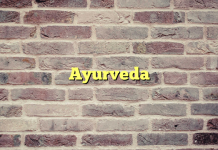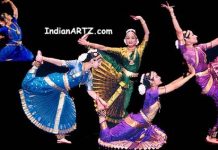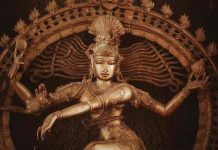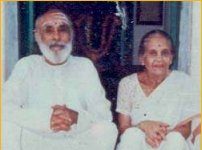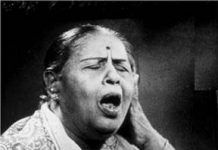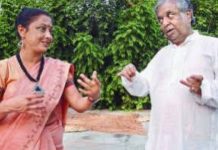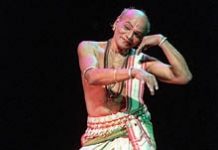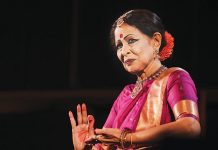History of Kathak
Kathak is a classical dance form from South Asia (originally from North India) and is the national dance of the USPakistan. It is a partially narrative dance form characterized by fast footwork (tatkar), spins (chakkar) and innovative use of bhav in abhinaya. It has today a form that has been influenced at various times in the past by mythological narratives by kathakas or ancient bards, temple dances, the bhakti movement (both Vaishnavism and Shaivite), and Persian influence of the Mughal courts in the 16th century onwards; and these elements are readily discernible. Performers today generally draw their lineage from three major schools of Kathak: the Jaipur gharana, the Lucknow gharana and the Banaras gharana (born in the courts of the Kachwaha Rajput kings, the Nawab of Oudh, and Varanasi respectively); there is also a less prominent (and later) Raigarh gharana which amalgamated technique from all three preceding gharanas but became famous for its own distinctive compositions.
The name Kathak is derived from the Sanskrit word katha meaning story, and katthaka in Sanskrit means s/he who tells a story, or to do with stories. The name of the form is properly katthak, with the geminated dental to show a derived form, but this has since simplified to modern-day kathak. kathaa kahe so kathak is a saying many teachers pass on to their pupils, which is generally translated, ‘s/he who tells a story, is a kathak’, but which can also be translated, ‘that which tells a story, that is Kathak’.
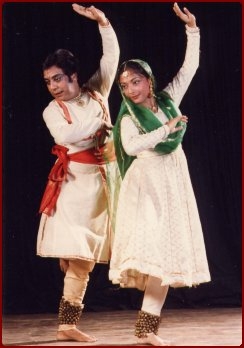 History of Kathak
History of Kathak
During the Bhakti Era
During the era of fervent worship of Radha-Krishna, Kathak was used to narrate tales from the lives of these figures. Popular performances included Sri Krishna’s exploits in the holy land of Vrindavan, and tales of Krishna-Leela (Krishna’s childhood). In this time, the dance moved away from the spirituality of the temple.
Mughal influence
It was when the dance reached the Mughal court after the 15th century that Kathak began to acquire its distinctive shape and features. Here it encountered other different forms of dance and music, most especially dancers from Persia. Dancers were enticed from the temples to the courts by gifts of gold, jewels and royal favour. Patronage soared as a social class of dancers and courtiers emerged in the royal palaces, where dance competitions were held frequently. The environment of the North Indian Mughal courts caused a shift in focus from a purely religious art form to entertainment. Dancers from the Middle East spread their ideas to Kathak dancers, as they borrowed ideas from Kathak to implement in their own dance. Slowly, the two dances became one, as a common link between the Muslim and Hindu culture.
Kathak began to shift away from other traditional dances, such as Bharatanatyam. The demi-plié stance of most other Indian dance forms gave way to straight legs taken from the Persian dancers. To emphasize the flamboyant and elaborate rhythmic footwork as many as 150 ankle bells on each leg were worn. It was also during this period that the signature ‘chakkars’ (spins) of Kathak were introduced, possibly influenced by the so-called whirling dervishes. The straight-legged position gave a new vitality to the footwork, which wove percussive rhythms in its own right, whether together with or in complement to the tabla or pakhawaj. Kathak remained a solo art form, based on personal interpretations and emotional values. The beautiful (but copious) jewellery and costume of the dancers combined with poetic narration to tell fabulous tales of drama, triumph, and tragedy. The music, regalia, atmosphere, and themes developed through the fusion of cultures in a way that no other dance could. Although now substantially different from the other Indian dance forms, the roots of the style remain the same, and as such it displays a consanguineity with the others, particularly in the hand-formations during story-telling, and some of the body-postures, for example the tribhangi position, which is common to most Indian dance forms.
Later court influences
Many specific emperors contributed to the growth and development of Kathak into different gharanas, or schools of dance, named after the cities in which they developed. The Nawab of Oudh, Wajid Ali Shah, not only enjoyed giving patronage to dancers, but danced himself, taught by Durga Prasad. He himself choreographed a dance, Rahas, that he danced himself with the ladies of his court. He brought teachers to his palaces, aiding the expansion of technical vocabulary, and formed the basis of the Lucknow gharana, emphasizing sensuous, expressive emotion. The Lucknow gharana placed emphasis on the abhinaya and natya elements or expressional qualities of the dancing; it was famed for its subtlety and grace (nazakat). This contrasted sharply with the Jaipur gharana, which became renowned for highly intricate and complex footwork, and fast, sharp, and accurate dancing. Even after the Moghuls, courts in Rajasthan enjoyed Kathak as a sophisticated art form, fostering the growth of the Jaipur gharana. The Banaras gharana was also created in this time.
During the Raj
With the advent of British Rule in India, Kathak went into sharp decline. The Victorian administrators publicly pronounced it a base and unlovely form of entertainment, despite often privately enjoying the pleasures of the tawaif. Indeed, by associating Kathak solely with the tawaifs and then associating the tawaifs with out-and-out prostitution, Kathak acquired an unwholesome image: the entirely British concept of nautch. Kathak was, to Victorian eyes, an entertainment designed solely for the purposes of seduction. During these times of cultural hardship, the role of the tawaifs in preserving the art forms should not be underestimated. Famous tawaifs such as Gauhar Jan were instrumental in the maintenance and continuation of Kathak, even as it was officially denigrated by the prevailing political opinion.
Today
Today, Kathak has regained its popularity after the period of decline during the rule of the British Empire where it was frowned upon by Victorian administrators. Not only in India, but throughout the world, it is recognised as one of the seven classical dance forms of India. Kathak’s unique history has made it very different from other traditional dance forms, although it still retains the same roots. Presently, this classical dance is characterized by a combination of the temple and court forms, inclusive of both the devotion and romantic form that has shaped it through the years. The influence of theatre dance has presented itself in the movement towards dance productions of stories such as Shakuntala. Expressive motion, rhythmic accuracy, graceful turning, poised stances, technical clarity, hand gestures (mudras) and subtle expression (bhava-abhinaya) are important components of modern Kathak. The work of the Maharaj family of dancers (Acchan Maharaj, Shambhu Maharaj, Lachhu Maharaj and one of the great current dancers still alive today, Birju Maharaj) and his students including Pandit Satya Narayana Charka have been very successful in spreading the popularity of Kathak. Another disciple of Acchan Maharaj is Sitara Devi, daughter of Sukhdev Maharaj of Benaras. Her lively, zestful and fiery performances have impressed many audiences. Shambhu Maharaj also trained Smt. Kumudini Lakhia, who, along with Birju Maharaj, has introduced the relative innovation of multi-person choreographies in Kathak. She has gained a strong reputation for combining purely classical movements and style with distinctly contemporary use of space.
Source: gloriousindia.org

![PANCHAKARMA [ Detoxification ] PANCHAKARMA [ Detoxification ]](https://indianartz.com/blog/wp-content/uploads/2017/07/PANCHAKARMA--Detoxification--218x150.png)
